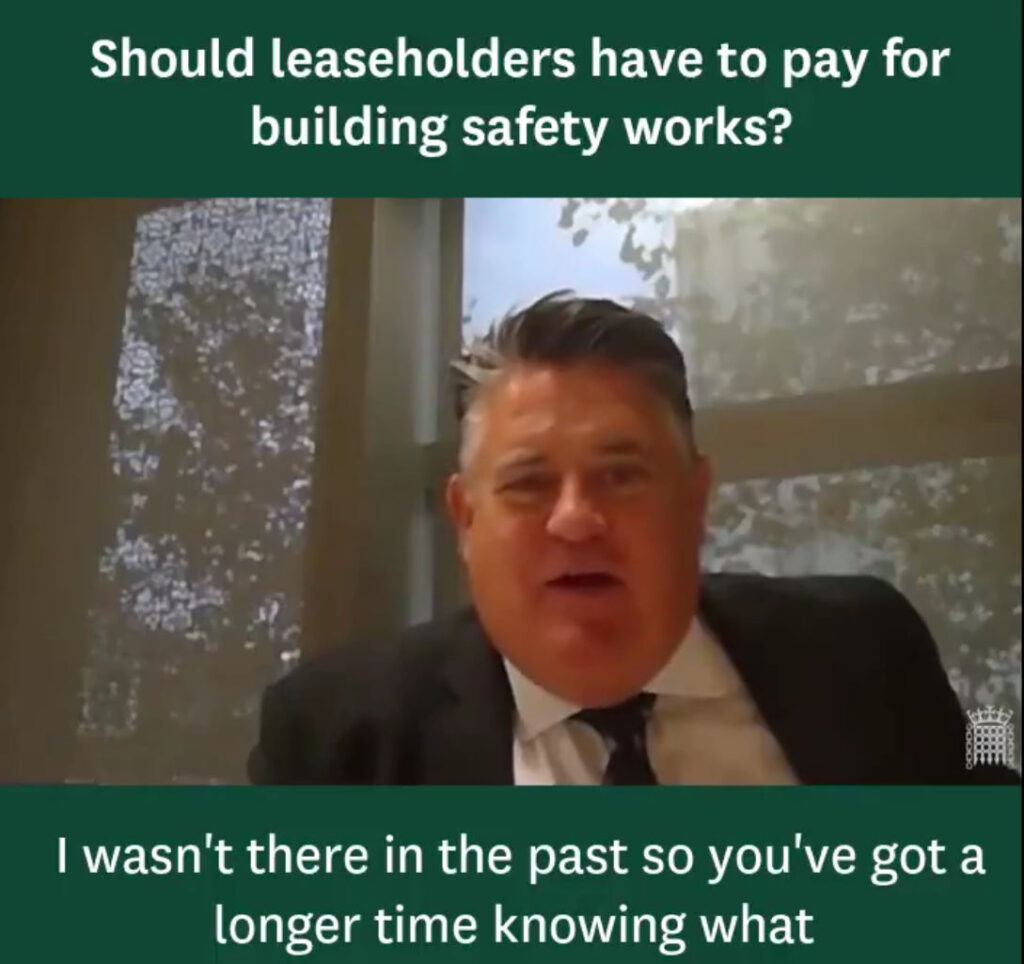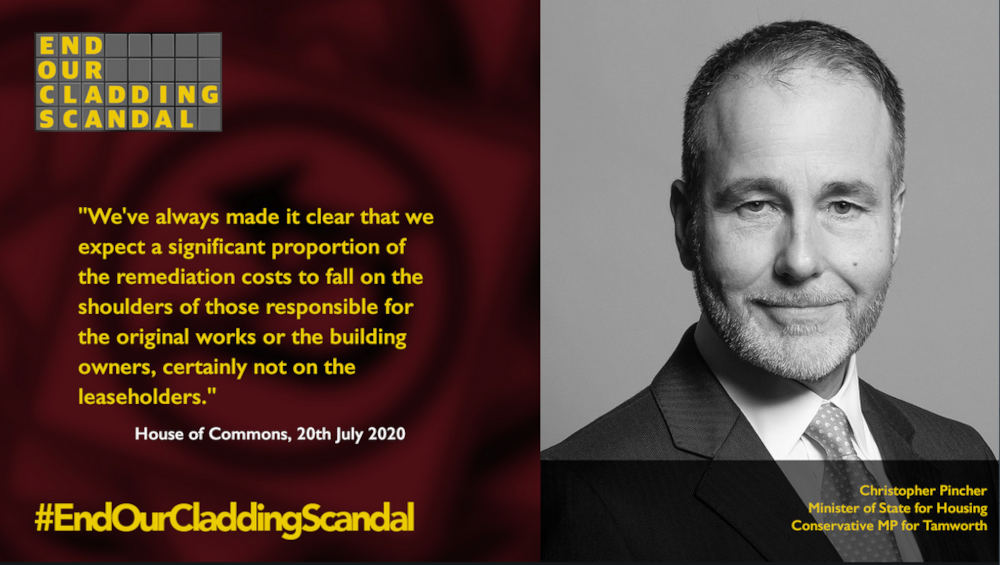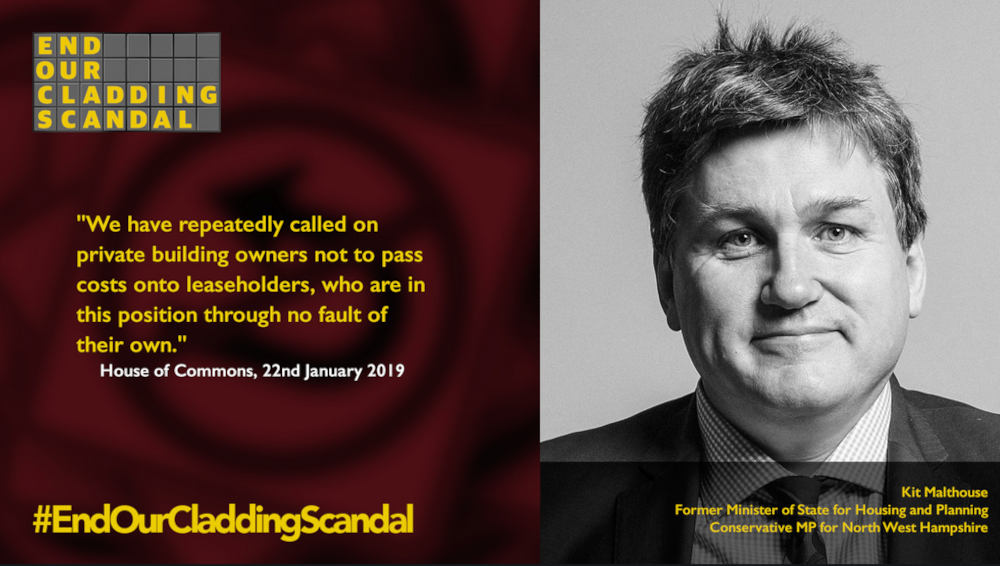And this is from the minister in whom we invest our hopes for leasehold reform …

For the first time in three years a government minister has said that the cladding bills will land on leaseholders, but they will have to be “affordable”. Up until now, all previous ministers – including former prime minister Theresa May – have said that the huge bills to remedy build defects should not land on the unwitting leaseholders.
After all, they are simply consumers who bought leases in flawed buildings.
But astonishingly in the UK that means fewer consumer rights than buying a washing machine.
Lord Stephen Greenhalgh, the housing minister charged with both cladding and wider leasehold reform, gave the clearest indication that government is, in fact, expecting leaseholders to pay to remediate their buildings.
He was being questioned on Monday by Labour MP Clive Betts, who chairs the Communities Select Committee.
Clive Betts: “Ministerial comments before were that these costs should not fall on the leaseholders. I think that is quite a significant change of wording isn’t it?”
Lord Greenhalgh: “It has to reflect the complexities of English property law. Now I studied land law in the 1980s so it is a long time ago since I knew exactly how the landlord and tenant system works. But it is down to individual leases which determines who pays …
“If the freeholder does not decide to do the right thing in law then the leaseholder – and it [the site] is out of warranty – then it is the leaseholders who face the bill, if you like, without intervention.”

Betts: “That is the heart of the problem, isn’t it? That may well be the legal case that leaseholders are legally obliged to foot the costs. But the reality is that they can’t. The reality is that those buildings are going to stand unremediated if those leaseholders can’t pay.
“They are going to be destitute in many cases. I thought that was the whole idea of government funding was to stop that happening.”
Greenhalgh: “ … I want to make very clear that it is not unaffordable for leaseholders.”
This means that the £1.6 billion public money so far pledged is likely to be the total, even though it is far from adequate.
The money has also been allocated randomly, irrespective of a building’s risk. So if a building has the dreaded association with ACM “Grenfell cladding”, it is quids in.
On the other hand, it an applciation was late to apply for the non-Grenfell £1 billion fund – or does not qualify because the building is less than 18 meters – the leaseholders are on their own.
And government is going to resist further payouts.
It may not succeed in doing so. Many leaseholders facing utter ruin are young first-time buyers – a generation of buyers who have come off renting – who are to be left unassisted while the government preaches “Build Back Better” to get another renting generation to get onto the housing ladder.
The mistake of the victims? They trusted plc house builders – whose brands are often household names – and ended up in properties that are dangerous and now valueless.
They trusted government. First, the regulations, which signed these buildings off as safe and made them acceptable to mortgage lenders.
Second, they trusted the Help To Buy scheme – which accounts for £16 billion loans in the housing market – not to lend on a combustible and badly built buildings.
Third, they trusted former ministers – Sajid Javid, James Brokenshire, former prime minister Theresa May – who all said that leaseholders should not pay for mistakes made by others.
‘Cost of removing cladding is ripping our lives apart’
People living in flats with Grenfell-style flammable cladding have reacted with anger to a government minister suggesting they will have to pay towards the cost of replacing it themselves. The Building Safety Minister, Lord Greenhalgh, says costs will be kept “affordable” and the government has set up a £1.6bn fund to pay for repairing taller tower blocks.
LKP has been warning government about this disaster since June 2017. We were advising leaseholders at Citiscape in Croydon from November 2017, and flagging up “gargantuan bills” facing leaseholders at the APPG of December 2017.
Ministers repeated the mantra that freeholders should “do the decent thing” and pay to remediate “their buildings”.
Again and again, LKP said this would not happen; that anonymous offshore punters in residential property’s income streams had no reputation in the game and, in many cases, the multi-million bills dwarfed the tiny ground rent incomes involved.
We gave the example of Northpoint, in Bromley, where £4 million of cladding remediation is needed, but where the freeholder Tchenguiz organisation gets only £7,000 a year in ground rents.
Leaving aside any consideration of Vincent Tchenguiz’s philanthropic nature, he certainly wasn’t going to pay £4 million at Northpoint.
Yet again and again – most recently Lord Greenhalgh at the Communities Select Committee – repeats what is SIMPLY NOT TRUE: that freeholders and developers have paid to remediate buildings.
In fact, no freehold investor – sorry, “long term responsible custodian” – in the ground rent game has done so.
And plenty of freeholders have gone off to court to make sure that leaseholders – and not themselves – are legally liable to pay for removing the cladding.
It is for this reason that LKP links the cladding disaster to wider leasehold reform: what is the point of these third-party, freehold speculators and how come they are the landlord / building owner when their asset is worth 1-3 per cent of the building compared with the leases?
Should they have their over-weighted, privileged position in law? Above all, why on earth should taxpayers bail out these punters – some of the worst in the property game – by toshing up their blighted blocks of flats?
These “building owners” are never the building owners when it comes to paying any bills, only when it comes to taking the incomes.
Hilary Benn is the first MP to suggest that the bail-out money should involve a stake in the freehold:
After all, if these leases in blighted buildings are valueless, then so are the freeholds.
Where Lord Greenhalgh may have a point, though he is yet to make it, is: should young taxpayers who are not even on the property ladder – and may have little prospect of being on it – bail out slightly older home owners who are?
It is awful that there is no established fault here, and it is quite deliberate.
The officials who preside over building safety also presided over this regulatory mess and they are still in situ. Indeed, enhanced: the building safety team is 80 strong. They should have been cleared out after Grenfell.
Together with their friends in the privatised and developer-nobbled Building Research Establishment, they dreamed up the regulations.
But government blames developers for the cladding mess, and developers blame government, and with no court ruling the matter is unresolved. So government can – and is – dealing with this crisis on terms they are completely of its own choosing.






 Government should have equity stake in cladding freeholds covered by the fund, Hilary Benn MP tells APPG
Government should have equity stake in cladding freeholds covered by the fund, Hilary Benn MP tells APPG






















I know of no house builder in the UK suffering financial loss at the current time, indeed their profits are very often eye watering, and still they build poor quality homes that are now even unsafe. The builders who built the unsafe properties should be legally enforced to put things right at cost to themselves and their shareholders. This should be a fight between builder and freeholder, not the leaseholder. I can see nothing changing whilst political parties are funded by private donation also known as bribery.
ISNT THIS A LATENT DEFECT FOR WHICH THE BUILDER IS RESPONSIBLE FOR IN LAW 15 YEARS FROM THE DATE OF DISCOVERABILITY? LATENT DEFECTS ACT.
Gov UK deregulated the planning process and thereby is directly responsible for allowing unqualified members of Planning Committees to completely ignore fire safety design and specification
Instead they would rely upon proposals put forward by developers and without any risk analysis
Until Grenfell Local Authorities preferred to focus on (inter alia) bicycle shed and landscaping layout and design and very often had Overage Agreements (profit sharing) in place in addition to Section 106 planning levies
The Government can’t have it both ways. It is either there to protect its citizens or not.
Given its Health and Safety interventions as a result of Covid-19, its failure to implement a national strategy which obliges Local Authorities to have effective Fire Safety design planning in place should make it directly liable for all/any remediation works which were a consequence of deregulation
Gov UK deregulated the planning process and thereby is directly responsible for allowing unqualified members of Planning Committees to completely ignore fire safety design and specification
YOURE CONFUSING PLANNING WITH BUILDING REGS!
Totally off topic – Having been bitten eighteen months ago when I began, and then abandoned, the process of buying the freehold of my bungalow, I am now looking at doing it DIY. Can anyone suggest a book to guide me?
Let’s be clear. This is not a tenure issue. Indeed, if these blocks were commonhold, when the units would be held freehold, there would be no-one other than the flat owners to meet the costs of remediation, without government support. It is muddying the waters to represent this as a problem with leaseholds. It is not. It is in fact a gross failure of regulation and building control to which tenure is irrelevant. As such, the full costs should be met by government, not dumped on the flat owners.
Sorry this is wrong. On a commonhold site the owners would have a much clearer means to take action against the developer. Under leasehold law its much more difficult
This is seen in Australia and the govenment then provides support for sites which are older.
I have no idea why you think that. Clearly someone who has a leasehold interest would have a cause of action for loss suffered to that interest just as much as someone with a freehold interest. But it would clearly be arduous to pursue without any certainty of success. The point is that the government needs to be the primary target.
I fully agree the government needs to intervene but remember the rules in commonhold are very different so developers would be a lot less inclined to bend the rules.
If I live in a commonhold site with 200 flats and we have a problem that needs to go to court against the developer we make an commonhold assessment and raise £500 per flat and everyone needs to pay. We as the commonholders now have £100,000 to start to take the developer to court and can raise more money if we need.
In the leasehold world I would be lucky if I were chair of the residents group if I got £50 from a subset of the leaseholders that I could find. If I got £5 or 10K it would take a lot of work. The lawyers might tell me I also need to be taking action against my landlord as I may not have a direct right to sue the developer and the landlord would have the right to charge their legal costs to all the leaseholders in defending any action.
It could also be that my landlord has a cosy deal with my developer to buy the freeholds from the new blocks they happen to be developing so would be keen to stop me taking action. It might even be the financing arm of the landlords company lent the money to the developer of my site to build in the first place.
There are a lot of golden geese in the leasehold world.
So thats why I think that it would be very different in a commohold world which is maybe also why so many landlords and lots of developers are campaigning behind to scenes to stop commonhold on larger sites.
Well its all quite simple why the Government won’t admit responsibility ….
LEASEHOLDERS DON’T DONATE LARGE SUMS OF MONEY TO TORY PARTY FUNDS.
To rub salt in the wounds, Leaseholders will be taxed for carrying out remediation work! As things stand VAT will be charged against building works this adding 20% to the bill. I have written to Lord Greenhaulgh seeking his support for ensuring all building work relating to remediation is zero rated. No reply so far!
A recent Tribunal decision agreed that such work can be deemed to be “snagging” for VAT purposes and will attract zero rating. Surprise, surprise though. HMRC have said that, to qualify, the building must still be owned by the original owners or developers. This, as they well know, will disqualify a significant number of applicants because the “guilty parties” have moved on!